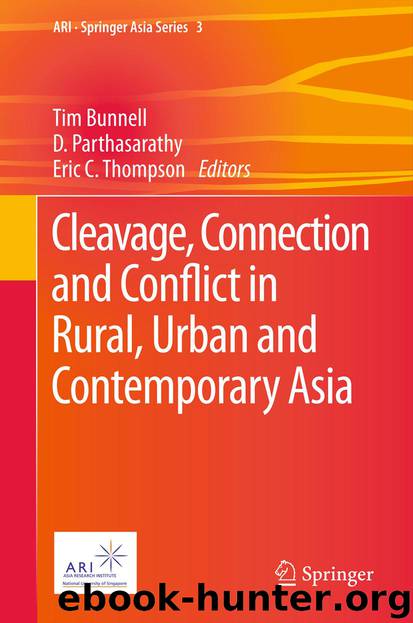Cleavage, Connection and Conflict in Rural, Urban and Contemporary Asia by Tim Bunnell D. Parthasarathy & Eric C. Thompson

Author:Tim Bunnell, D. Parthasarathy & Eric C. Thompson
Language: eng
Format: epub
Publisher: Springer Netherlands, Dordrecht
The feelings of “insideness” and a sense of belonging are pitted against feelings of “outsideness” and non-belonging, thereby giving rise to irreconcilable visions of the way space ought to be used and developed (Chang 2000). However, Chang (2000) argues that “insider” and “outsider” boundaries are not as clear-cut. Instead, they are fluid and open to negotiation. This is because different people possess differing conceptions of “insideness,” in turn, giving rise to varying senses of attachment and belonging to place. Different people are either “insiders” or “outsiders” depending on their goals, ethnic ties, or economic links to a place. “Insider-outsider” relationships are, at times, conflicting and yet, at other times, complementary. Kong (1991), meanwhile, sees Relph’s concept as suggesting many subtle shadings of “insideness” and “outsideness” rather than simply a static dichotomy. Human interaction with place is seen to fall somewhere along a continuum between two polarities. The boundaries between “insideness” and “outsideness” are porous rather than concrete, and people’s relationship with place may be transformed over time from one end to another and vice versa (Kong 1991, p. 54, cited in Chang 2000).
The effect of images, on the other hand, is to shape how people understand themselves spatially and recall the world in mental maps in order to situate themselves (Crang 1999). These images are the community’s own experiences as they are remembered or memories of images produced by others (Wolford 2004). These remembered spaces are shaped by people’s experiences, tasks, and roles that they have at hand. Images create a relationship between the perceiving subject, the viewed object, and the relationship between them (Crang 1999). This leads to feelings of love for and fear of place, space, and landscape.
People’s love of place, topophilia, meanwhile, explains the affective bond between people and their place in the world. People’s relation with nature, their geographical behavior, as well as their feelings and ideas with regard to space and place appear to have an effect upon the differences in the ways that they perceive and are attached to the place (Tuan 1974, 1979). Human experiences, awareness, and knowledge raise different levels of consciousness and perceptions toward place. This results in the various ways in which people respond to place such as personal and lasting appreciation of landscape and awareness of the past that generates patriotism (Peet 1998). This explains why people protect and preserve their place and beloved landscapes and why nonmaterial culture is preserved in language, religion, and other tradition and customs. All of these give a certain social atmosphere that is appreciated by its residents and is sometimes advertised as an attraction (de Blij and Murphy 2003; Driver 1999).
Rapid urbanization and industrialization from the twentieth century have brought about drastic changes to natural environments and old settlements. Relph (1976, p. 81) argues that the technical approaches of much physical and social planning are clearly inauthentic, in which objects are manipulated for public interest and decisions are taken in a world of assumed, homogenous space and time. Inauthenticity is the prevalent mode of existence in industrialized, mass society.
Download
This site does not store any files on its server. We only index and link to content provided by other sites. Please contact the content providers to delete copyright contents if any and email us, we'll remove relevant links or contents immediately.
Kathy Andrews Collection by Kathy Andrews(11683)
The remains of the day by Kazuo Ishiguro(8751)
Paper Towns by Green John(5026)
Spare by Prince Harry The Duke of Sussex(4999)
The Body: A Guide for Occupants by Bill Bryson(4889)
Industrial Automation from Scratch: A hands-on guide to using sensors, actuators, PLCs, HMIs, and SCADA to automate industrial processes by Olushola Akande(4850)
Machine Learning at Scale with H2O by Gregory Keys | David Whiting(3976)
Be in a Treehouse by Pete Nelson(3878)
Harry Potter and the Goblet Of Fire by J.K. Rowling(3742)
Never by Ken Follett(3708)
Goodbye Paradise(3668)
Into Thin Air by Jon Krakauer(3263)
The Remains of the Day by Kazuo Ishiguro(3256)
The Cellar by Natasha Preston(3222)
The Genius of Japanese Carpentry by Azby Brown(3194)
Fairy Tale by Stephen King(3159)
120 Days of Sodom by Marquis de Sade(3120)
Drawing Shortcuts: Developing Quick Drawing Skills Using Today's Technology by Leggitt Jim(2962)
The Man Who Died Twice by Richard Osman(2959)
